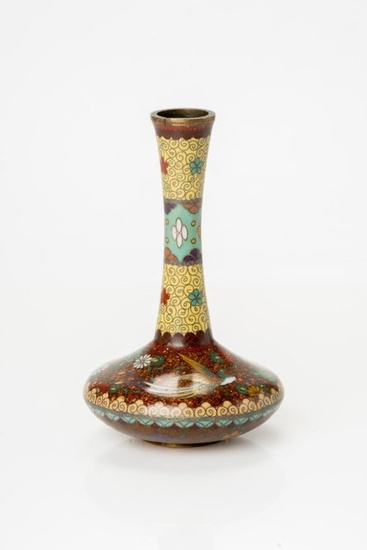Vase - Aventurine, Cloisonne enamel, Gold thread, Silver thread - A fine cloisonné vase worked in silver & gold wire & aventurine stone with Phoenixes 鳳凰 & flowers - Japan - Meiji period (1868-1912)
A fine cloisonné vase finely crafted in silver wire, with a circular disc-shaped base and elongated neck.
Polychrome enamels and crushed aventurine stone, which creates a shimmering effect, are cleverly combined to depict a group of phoenixes 鳳凰 in flight, a symbol of nobility and regeneration. The Phoenixes are painted with great detail and grace, their fluttering wings and finely outlined feathers giving a feeling of movement and lightness. Around the representation of the Phoenicians, there are delicate and charming floral motifs.
The cloisonné technique involves applying thin metal divisions to the surface of the vase, creating separate sections called "cloisons". These divisions are then filled in with polychrome glazes, creating a vibrant and luminous effect.
---The vase is in excellent condition. Please refer to the pictures for more details.
The history of bronzes, silvers and enamels is closely linked to that of an iconic figure of Japan: the Samurai. Throughout the Edo period, i. e. from 1603 to 1868, the effective control elite of the territory was precisely that of the Samurai. In fact, they were the ones who governed, under the guidance of the Daimyo, the various provinces of the country.
When the Edo period ended and the Meiji Restoration began, Japan's social structure underwent a radical change.
On March 28, 1876, the Haitorei edict was issued. This provision prohibited samurai from carrying swords in public, on pain of confiscation of the weapon.
This state of affairs threw the metal craftsmen into turmoil who suddenly found themselves without trade.
It was only an initial phase, however, because within a short time the craftsmen themselves reinvented themselves. Over time they had in fact refined extraordinary artistic skills. Therefore, declining their mastery in an alternative production was almost a natural consequence. As they could no longer devote themselves to the manufacture of accessories for armor and swords, they began producing items for daily use. And in many cases of decorative objects.
It was the beginning of a great success. Soon the copious artistic production had concrete results. It did not go unnoticed by foreign diplomats, travelers and military advisers who were in Japan at the time.
But national borders were soon crossed and Japan's participation in world fairs and exhibitions was not long in coming. Hence the real explosion of interest in these sublime works of art. All this translated into an increase in demand from Europe and Anglo-Saxon countries in particular, which still appreciate Japanese art today.
--- We will pack your item with extreme care and entrust it to DHL or UPS who will take care of delivering it within 1-3 days. Insurance is included.
The certificate of authenticity compiled by Luca Mastromauro, an expert in Japanese art will be delivered to the buyer. ---
565
View it on
Sale price
Estimate
Time, Location
Auction House
A fine cloisonné vase finely crafted in silver wire, with a circular disc-shaped base and elongated neck.
Polychrome enamels and crushed aventurine stone, which creates a shimmering effect, are cleverly combined to depict a group of phoenixes 鳳凰 in flight, a symbol of nobility and regeneration. The Phoenixes are painted with great detail and grace, their fluttering wings and finely outlined feathers giving a feeling of movement and lightness. Around the representation of the Phoenicians, there are delicate and charming floral motifs.
The cloisonné technique involves applying thin metal divisions to the surface of the vase, creating separate sections called "cloisons". These divisions are then filled in with polychrome glazes, creating a vibrant and luminous effect.
---The vase is in excellent condition. Please refer to the pictures for more details.
The history of bronzes, silvers and enamels is closely linked to that of an iconic figure of Japan: the Samurai. Throughout the Edo period, i. e. from 1603 to 1868, the effective control elite of the territory was precisely that of the Samurai. In fact, they were the ones who governed, under the guidance of the Daimyo, the various provinces of the country.
When the Edo period ended and the Meiji Restoration began, Japan's social structure underwent a radical change.
On March 28, 1876, the Haitorei edict was issued. This provision prohibited samurai from carrying swords in public, on pain of confiscation of the weapon.
This state of affairs threw the metal craftsmen into turmoil who suddenly found themselves without trade.
It was only an initial phase, however, because within a short time the craftsmen themselves reinvented themselves. Over time they had in fact refined extraordinary artistic skills. Therefore, declining their mastery in an alternative production was almost a natural consequence. As they could no longer devote themselves to the manufacture of accessories for armor and swords, they began producing items for daily use. And in many cases of decorative objects.
It was the beginning of a great success. Soon the copious artistic production had concrete results. It did not go unnoticed by foreign diplomats, travelers and military advisers who were in Japan at the time.
But national borders were soon crossed and Japan's participation in world fairs and exhibitions was not long in coming. Hence the real explosion of interest in these sublime works of art. All this translated into an increase in demand from Europe and Anglo-Saxon countries in particular, which still appreciate Japanese art today.
--- We will pack your item with extreme care and entrust it to DHL or UPS who will take care of delivering it within 1-3 days. Insurance is included.
The certificate of authenticity compiled by Luca Mastromauro, an expert in Japanese art will be delivered to the buyer. ---
565



